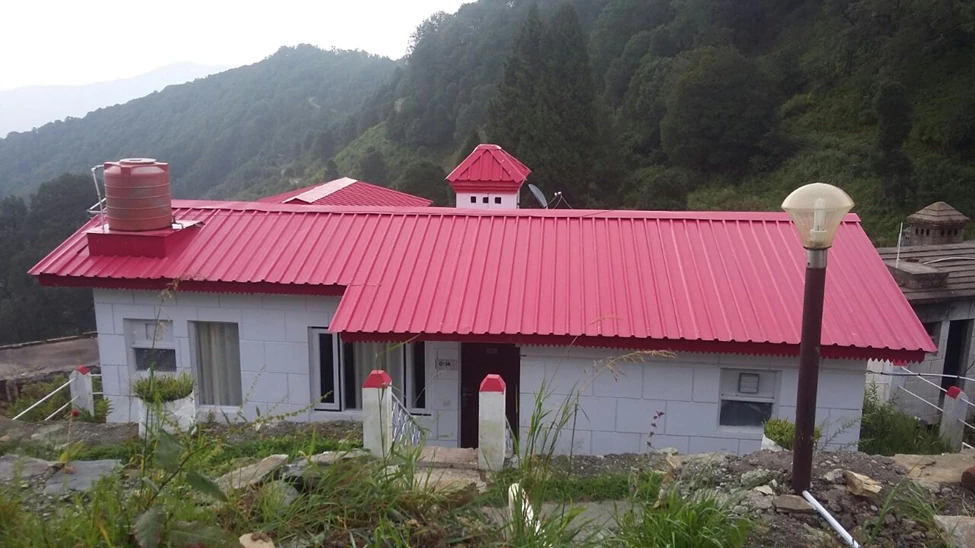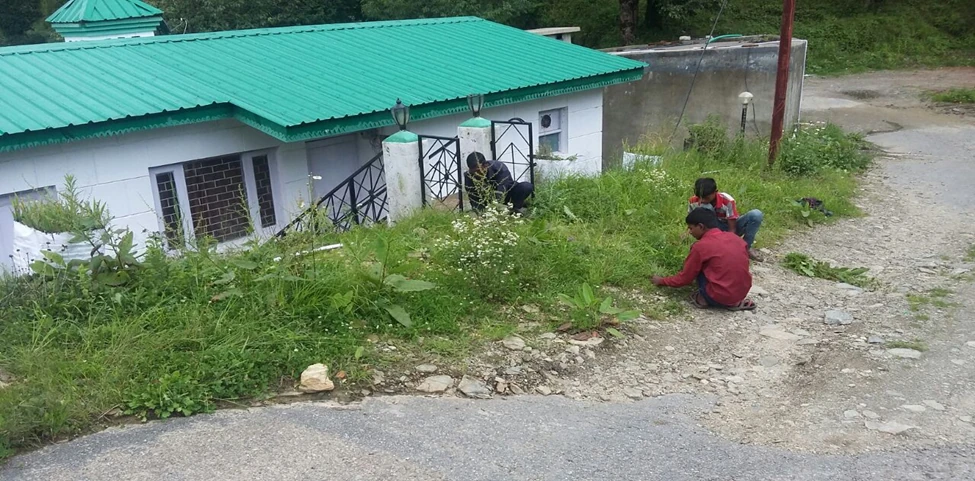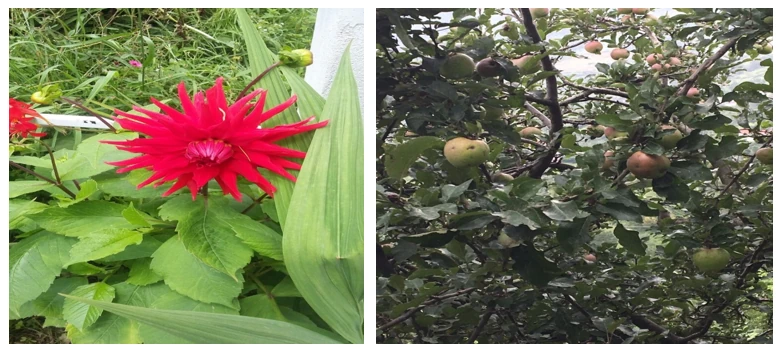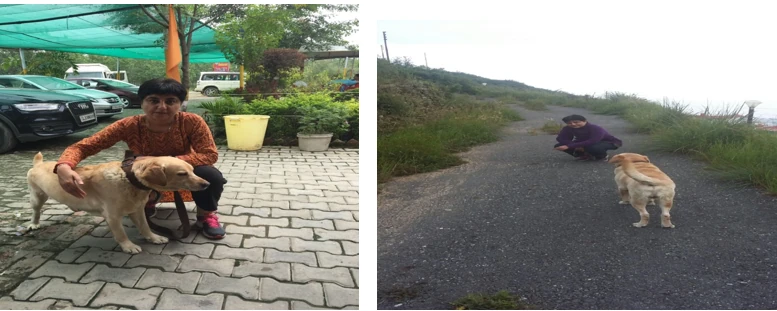The LONG Week End-12 Aug to 15 Aug 17
Though we are a veteran couple, our daughter Neerja (Nanu is her pet name) has a very busy schedule round the year with long working hours and travel schedules within India & abroad. Despite official hagglings of this meeting and that conference schedule, she had planned to spend a quiet extended weekend break to refresh and rejuvenate at a less frequented hill destination in Uttarakhand. She completely ruled out visiting Ranikhet and Nainital, where she lived and studied, respectively, for half a decade during her childhood. She also ruled out Shimla and Mussoorie, and we narrowed it down to Bull Kumar’s Shivpuri Resort, located in a lush green forest on the road 15 km across Rishikesh to Badrinath. Unfortunately, the resort was fully booked, and we settled down for our next option and good offer from my senior Signals friend Brig Puri to revisit his cottage in Cloud Nine, nestled amidst a lush green forest and landscaped apple orchards on the main Bhowali-Ramgarh-Mukteshwar road in the Dev Bhoomi Kumaon Himalayas. I suggested revisiting Cloud Nine, as we had previously enjoyed his hospitality some three years ago. The other main consideration of this holiday was taking our pet Lab, Happy Bhatia, which was only acceptable at Shivpuri Resort or Cloud Nine.
Since I have traveled nth times on this route, after hurriedly packing our minimum essentials—clothing, snacks, and foodstuff—on 12 Aug we left around 8 am, following the conventional route Noida-Gajraula-Moradabad-Rampur-Bilaspur-Rudrapur-Haldwani-Bhimtal-Ramgarh to Cloud Nine, located around 350 km from Noida. The road journey was uneventful as it was full of cars, minibuses, and taxis of holiday revelers speeding up to make the most of their upcoming four-day weekend. The road from Rampur to Rudrapur is bad, with big potholes and all sorts of traffic snarls—bullock and horse carts, tractors, trucks, cycles, and e-rickshaws. We had lunch at roadside Punjab Di Potli Dhaba, short of Bilaspur, and the food was indeed good, especially the dal makhani cooked in desi ghee. We passed through 5 toll barriers, and though the first four exempted the toll showing my ex-serviceman card, the fourth near Rampur would not agree, and we paid Rs 110 toll—the highest so far for traveling four km, as the road beyond Rampur towards the hills around Bilaspur, Rudrapur, and Haldwani was chaotic except for me, who has an emotional bond, having lived and stayed in a farm near Bilaspur as I did my matric from Rudrapur way back in 1957. Near Kathgodam, from a small shop, Harish Store, we had a short stop to purchase bread, butter, eggs, and milk, and to my amazement, it was located next to diehard Berari Col. Chowdhury’s house. Since we wanted to avoid driving in hills in darkness, I reluctantly planned to meet him on our way back. Unfortunately, that plan did not come to fruition in the end.
The Swiss Village in the Himalayas
The hills start from Kathgodam, and so does the cool breeze of the mighty Himalayas. The sal, deodar, and rhododendron trees with red flowers, famous for making wine and syrupy red juice to rejuvenate tired mind, body, and soul, gradually start replacing the pine trees with their peculiar fragrance. Due to silvery clouds majestically gliding over the Bhimtal, we could not see the serenity of the lake and surrounding hills, as the entire Bhimtal Valley looked like an ocean.
After a quick hot tea with pakoras at Bhowali, we took our last leg of 33 km drive to Ramgarh, divided as Malla (higher elevation) on the main road and Talla (lower elevation) on a side road. Located at the height of 7200 feet, it is the fruit bowl of the Kumaon region, famous for its delicious apples, apricots, peaches, and pear orchards. Ever Since Nainital has become air-conditioned and overcrowded and Karol Bagh and Ranikhet seem bursting with tourists, Ramgarh and Mukteshwar have emerged as exquisite tourist destinations. The erstwhile Cloud Nine, located around 12 km from Ramgarh towards Mukteshwar, has been renamed ‘The Swiss Village in the Himalayas’. There are large numbers of small, well-maintained cottages on narrow, winding, serpentine roads surrounded by thick forests frequented by the leopard(s) and tiger(s), and at the end of bend 11, at the height of 7500 feet, is located the red-roofed, neat, well-maintained O-14 cottage of Brig Puri, where we arrived around 5 pm and were destined to rendezvous for our short recouping holiday. The exquisiteness, tranquility, and breathtaking unobstructed views of the snow peaks of the Nanda Devi and the Trishul ranges of the Himalayas during clear weather beat the European Swiss Alpine serenities. I would like to compliment Mr. Sudhir Saxena and the entire team of the Swiss Village in the Himalayas for its excellent upkeep, F&B, security, and housekeeping services.


Immediately on arrival at the main gate, we were greeted by ever-smiling ‘Wahe Guru Wahe Guru’ chanting smart Sikh gentleman Ram Singh, who discreetly claims to be an ex-serviceman and heads security along with Eshwar Damodaran, the F&B Manager. We were given the key to O-14, and a motorcycle-borne guide took us to the cottage as it was getting dark, and silvery-grey clouds had engulfed the entire complex, making driving risky and slow. There was a cold breeze, and we shivered, and Happy looked very excited and scared, probably smelling a prowling big cat in the forest around us. We were tired; I brewed tea, ordered some food that’s very, very expensive from the resort’s restaurant, and went to sleep in the well-laid cottage.

Bagh (Tiger/leopard), Devi Devtas (Gods& Godesses) and Bhoot (evil spirits)
Kumaonis, though worshippers of Lord Shiva & Goddess Kalika, like all other hill tribes, believe in various village/local gods & goddesses, the presence of tigers and leopards commonly called bagh, and almost everyone has been influenced by the presence of bhoot or evil spirits. All hill tribes have one thing in common: they fear and revere the gods and goddesses, tigers, and the evil spirits—the latter two are believed to lurk everywhere with their mysterious powers. Their stealthy habits of suddenly appearing and disappearing in deep forests, high hills, and narrow valleys—often at night—elevate them to a supernatural status. No wonder the ever-smiling Gorkha security guard Thapa cautioned us of the invincible presence of these supernatural beings and tigers and leopards, which he referred to as ‘bagh,’ emphasizing that Happy must be protected by keeping him indoors during the night and poor visibility. Having lived many years in Ranikhet, my wife, Rajni, was deeply concerned about Happy’s safety and security.

The next morning we got up early, and Nanu and I went for a long walk with Happy on a winding downhill road with cottages interspersed along one side with red and green painted tops. There was an abundance of white butterflies attracted by a variety of flowers grown in the wild and in some of the well-maintained cottages. Ramgarh is good for those who love eerie silence, bird and butterfly watching, nature walks, yoga, meditation, and trekking. I and Neerja enjoyed walking with Happy, and while going downhill was tempting to cover longer distances, climbing on the way back exhausted us immensely. We drove in the afternoon to the local shop to purchase fresh vegetables that were much cheaper than the NCR and got freshly plucked apples from the roadside orchard at one-third the price of the Mother Dairy in Noida. Incidentally, many know Ramgarh as apple country, but the entire NCR is supplied with tomatoes grown here. While tomatoes were Rs 100 a kg at Noida when we left, these were available at Rs 30 a kg in the hills. Yes, there was a constant stream of cars laden with holidaymongers heading towards Mukteshwar, and by the evening of 13 Aug there were around ten holidaying families with kids enjoying an abundance of nature’s bounty in the Swiss Village. It was amazing; in one moment the entire area was engulfed with clouds gliding inside our cottage if doors and windows were open, while in the next few moments, it would be sunny with enjoyable warmth. Sadly, due to excessive construction of the multistoried buildings, commercialization and excessive tourism, and vandalism of forests by contractors, politicians, and bureaucratic mafias, the hearts of those who love these hills have been veritably saddened. I was equally saddened when I saw one resident tossing garbage in a polybag from his cottage window. Also, many visitors on holiday littered places with empty mineral water and whiskey bottles, empty cigarette packets, and poly packs, ruining the fragile ecosystem of the hills.
On the 14th, after our long morning walk, while Neerja read her books, I supervised wild grass cutting and pruning of plants in the cottage we were staying in (O-14) and the adjacent one, O-15, belonging to Brig Puri’s daughter, which had some guests. We both, to unwind and rejuvenate, enjoyed nature’s tranquility, peace, solitude, gentle cold breeze, and floating silvery clouds, far away from the hustle and bustle of our highly polluted Noida, enjoying nature walks with Happy and Sleep. Though we missed the wonderful view of the Himalayas due to the rainy season, the lush green valley was a joy forever. Rajni kept indoors, and mercifully, during the last day of our stay, after much cajoling of the housekeeping staff, some dish TV channels were activated so that she could watch some TV serials.
Incidentally, when we left our home for the hills, there was sadly a red alert on one TV channel announcing heavy rains and landslides in Uttarakhand in the next 48 hours. While my wife wanted to cancel the trip, I and Neerja persuaded her to take a chance. Throughout our stay, the sky remained heavily overcast with a high probability of rain.I love rains, especially the smell of hot pakoras and steaming mugs of tea, as well as the refreshing breezes. However, there are also lurking fears of landslides.rains Luckily there were no rains until we arrived back home with renewed synergy.
On 15 August, around 7:30 a.m., after a light breakfast, we left Cloud Nine for the way back home. It was heartening to see school kids carrying paper tricolor flags and buntings and singing patriotic songs, and at Bhowali, on the roadside, the school’s national flag was unfurled, followed by rhythmic singing of the national anthem. We also purchased the Kumaoni specialty ‘Baal Mithai’ from Bhowali. Surprisingly, none of the halwais knew its origin and were amazed when I narrated to them that it was invented by poor cook Joga Massih during World War I while he was serving in a British regiment. After the chaotic experience of traveling on poor road surfaces from Rampur to Rudrapur, we decided to proceed via the forested Kaladhungi road. Large numbers of two-wheelers, cars, tractors, auto-rickshaws, and trucks were seen flying the tricolor, but this tempo gradually declined as we progressed towards the NCR. While en route, we saw some barefooted sadhus on their padyatra; it was heartening to see a modern young sadhu driving on a new motorbike with a trishul and the national flag fluttering. With the drive through the lush green Kaladhungi forest and Jim Corbett and my regiment’s home, ‘The cool breezy Kumaon Hills,’ humming ‘Bedu Pako Barra Massa,’ one of our regimental songs, I desire visiting the hills again while my mind seems wholly taken up with reminiscences of Robert Frost’s famous stanza: –
‘The woods are lovely, dark and deep,
But I have promises to keep.
And miles to go before I sleep,
And miles to go before I sleep’.
